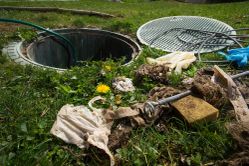What Should You Know About a Septic Drain Field?

Septic systems in rural areas consist of three main parts: the tank, perforated pipes, and drain field. The drain field often shows the first warning signs of a problem with the septic system. Here’s what you should know about the drain field and what you should look for when the septic system needs to be pumped.
What Is a Drain Field?
Whenever you flush your toilet or send liquids and food particles down the drain, the waste flows into your septic tank for separation. Solid waste sinks to the bottom, forming a sludge that bacterial enzymes slowly break down. Floatable matter, such as fat, oil, and grease, rise to the top to form scum. Wastewater flows through the perforated pipes connected to the tank and into the drain field. The water undergoes a natural filtration process through the soil that eliminates viruses, coliform bacteria, and other harmful contaminants before entering groundwater reserves.
When Do You Need Septic Pumping?
 When a septic system needs professional attention, the drain field can experience problems. An overloaded tank can clog a drain field with liquid and solid waste, resulting in odorous, damp areas or puddles on your lawn.
When a septic system needs professional attention, the drain field can experience problems. An overloaded tank can clog a drain field with liquid and solid waste, resulting in odorous, damp areas or puddles on your lawn.
You may also notice excessively green, tall grass over your drain field when the septic tank needs to be pumped. The extra nutrients in the soil from bacteria create lush grass because wastewater isn’t filtering efficiently, and solid waste may be present.
Schedule septic system services immediately if your drain field becomes saturated or overly green to avoid serious contamination problems. Maintain your septic system with assistance from Midwestern Plumbing Service, the plumbing company serving the Greater Cincinnati, OH, and northern Kentucky areas for over 35 years. Since plumbing emergencies don’t adhere to business hours, they are available 24/7. Call (513) 753-0050 today to schedule an estimate, or learn more about their services online. Get additional home improvement tips on Twitter.
About the Business
Have a question? Ask the experts!
Send your question

